While Brent Rooker is crushing home runs left and right, you might not have noticed another talented, previously unheralded player in Oakland. That’s JP Sears. While it’s easy to gloss over his 5.54 ERA on a historically bad team, he’s doing some good things. As of May 11th, his 19.5% K-BB% would be tied with Eduardo Rodriguez at 24th among qualified starters.
Sears, a South Carolina native, played three years of collegiate ball for The Citadel Bulldogs. In his Junior season, he was named the Southern Conference Pitcher of the Year and a Golden Spikes Award semifinalist before being drafted by the Mariners in the eleventh round of the 2017 draft. That year, he also ranked fifth in the nation with a 13.41 K/9.
He acquitted himself well in his pro debut with Single-A Everett and Clinton before being dealt to the Yankees in November 2017 for Nick Rumbelow. Four years later, he ended the season in Triple-A Scranton Wilkes-Barre where he posted a 2.87 ERA, 0.98 WHIP, and 26.5% K-BB% across 11 starts before being added to the 40-man roster.
Sears is friends with another former Yankee lefty, Jordan Montgomery. They’re both from Sumter, South Carolina and have trained together.
Last year, he made the Opening Day roster and debuted out of the bullpen on April 13th. He made his first start in late May against the Orioles, tossed five scoreless, struck out five, and picked up his first win. Not too shabby.
Sears made one final start for the Yankees in late June which fittingly came against his future team. He got sent down but plowed away in Triple-A to the tune of a 1.67 ERA, 0.72 WHIP, and a K-BB% of just under 30%. Pretty spicy stuff.
After being recalled two more times in July, Sears was sent to Oakland in the deal for Frankie Montas and Lou Trivino. He ended the season with a 3.86 ERA and 1.29 WHIP across 70 innings but with a below-average 17.7% K rate. This year, though, he’s striking out batters at a clip of 24.7%. So how’s he doing it?
Fastball
Getting swings and misses with the fastball is a very good skill to have. And Sears has demonstrated that so far this season. Through six starts, his fastball, which he’s thrown 51% of the time, has netted a 14.2% SwStr rate (89th percentile among SPs). Sears, of course, knows that his fastball plays well especially up in the zone, and he has been using it to his advantage.
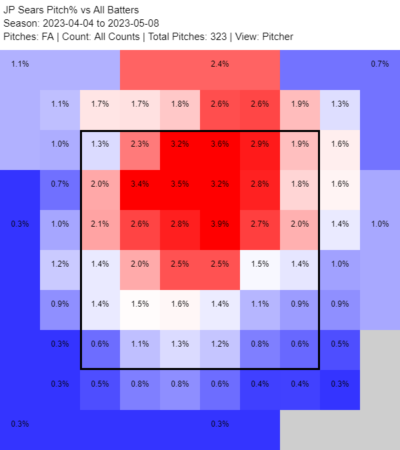
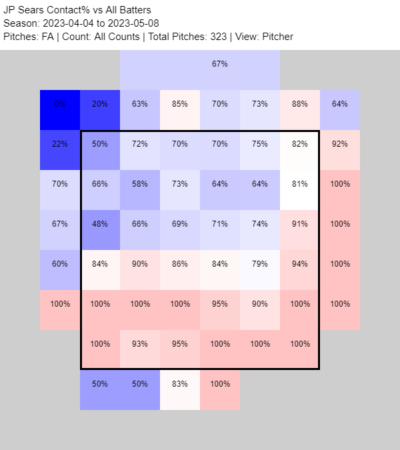
Above, you can see a heatmap of his fastballs followed by contact rates (via FanGraphs). Sears’ fastball netted just an 8.1% SwStr rate last season, so we’ve seen a pretty big leap.
Let’s look at it in action.
This is from his start on 5/8 against the Yankees. Yes, I’m cherry-picking as he was probably a little jazzed up playing his former team, but let’s have some fun.
Sears started this at-bat against Gleyber Torres with a sweeper (or slider depending on your source) for a called strike on the inner half and missed with another. He threw a 1-1 heater upstairs that Torres fouled off, but he gets him on the next one (above) for the punchout.
Earlier in the start, he got another proven hitter in DJ LeMahieu to swing and miss on a similarly located heater.
Here’s another good one against J-Rod versus the Mariners on 5/3. Impressive fastball command up in the zone with the catcher barely having to move his glove. The heater returned an impressive 31.7% CSW on 49 pitches in this start.
So we can see he gets whiffs while operating up in the zone with the heater. That’s great. But it’s also a ‘live by the sword die by the sword’ type of approach. Here is the not-so-fun part which is the fact that he’s yielded ten home runs so far, five on the fastball.
This is from his second start on 4/10 at Camden Yards. The catcher sets up high but Sears leaves it up around the belt. Sadly, Adley Rutschman did not miss.
Batted ball data is noisy early in the season, especially for pitchers but I think that there is something to Sears’ 13.3% barrel rate. Based on how he pitches, ie not having elite velocity and being up around the zone a lot, the home runs might stick around.
Slider/Sweeper
Earlier this spring, in addition to talking about how his fastball was, at the time, a little out of sorts, Sears said that he started throwing a sweeper. Although he differentiates the two by calling the new sweeper a slider and his normal breaking pitch, the one he throws to righties, a curveball.
Either way, besides sounding like a vacuum cleaner sold by your favorite department store, the Sears sweeper was designed with lefties in mind and features more horizontal movement. According to Sears, the biggest difference between the two is the grip.
Based on movement alone, I think it’s hard to tell where one ends and the other begins, but the sweeper is basically a flatter version of the slider. I tried to pick out a few decent examples just to illustrate how he uses his breaking pitch against lefties and righties.
The following GIFs were pulled from Baseball Savant where they’ve classified his breaking pitch into two categories: a sweeper (32.8%) and a slider (5.5%). These were all labeled as sweepers.
From his start against the O’s, we get a look at his sweeper. After jumping ahead on a high and away fastball for a called strike, he puts Cedric Mullins in an 0-2 hole with a deftly located sweeper. Although Mullin seems to disagree.
In the same at-bat, Sears shows some good glove-side command of the sweeper again and gets Mullins to roll over to second for the out.
Here’s another one thrown against Jarred Kelenic for the sixth of his seven punchouts against the Mariners on 5/3.
Here’s the slider, or curveball as he calls it, against switch-hitter José Ramírez.
Here’s another example of the slider that he likes to bury in the back foot against righties.
Note that the Pitcher List player pages, including PLV data, don’t differentiate between the slider and sweeper and put everything into the slider category. Separating the slider into two different buckets might technically be more accurate, but I don’t think it makes a huge difference for our purposes.
The more important takeaway for me is that the slider as a whole has been very effective this season. Sears has demonstrated exceptional command and control of the slider with a chase rate of 40.5% and a zone rate of 50.2%. Overall, it’s done the job and held batters to a .196 batting average (.182 xAVG) and .288 wOBA (.286 xwOBA).
As you can see below (via FanGraphs), he’s shown good glove-side command by jamming righties inside with the slider. Although, some of them have drifted a little too much over the middle of the plate.
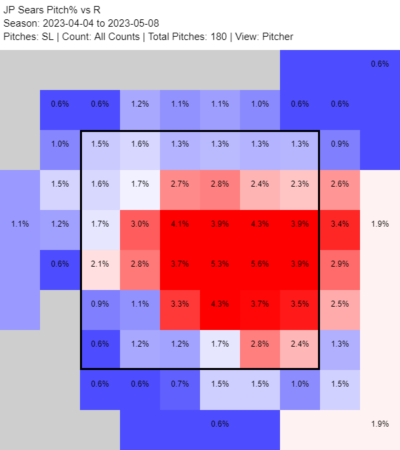
Changeup
Well, the changeup has its moments, but it’s clearly on the back burner. He’s thrown it a little less this year compared to a season ago from 17% down to 11%.
It’s returned a chase rate of 34.1% and a zone rate of just under 40% which aren’t too bad but the results have been including a .444 batting average and .508 wOBA allowed. Not great. But, hey, you gotta have a third pitch I suppose.
What does PLV say?
Sears first drew my attention while rummaging around the PLV app. As you’ll see, it believes he’s quite good. Just as a reminder, PLV grades are determined by looking at a variety of stuff including but not limited to velocity, location, vertical approach angle, lefty/righty splits, counts, and vertical/horizontal movement.
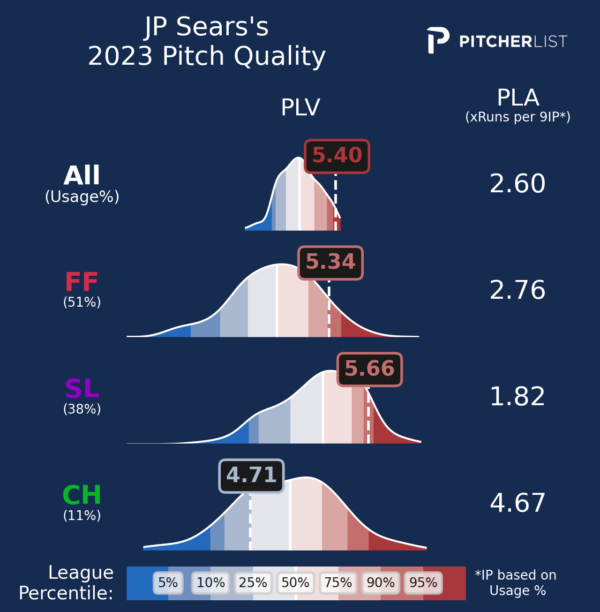
The slider grades out really well. Among all pitchers with at least 500 pitches, his slider’s PLA of 1.82 ranks eighth. Not bad. Let’s look at the list. Lists are fun, after all, they’re the reason we’re all here.
OK, so there are at least a couple of unexpected names here: Ryan Feltner and… Rich Hill?!? Hey, maybe the Rockies have something! No? Anyway, this is otherwise a pretty representative list as far as sliders go.
Sidenote, check out Mitch Keller’s slider plot on his player page — he’s showing off some great glove-side command this year.
So the slider grades well, but that’s just one part of the puzzle. The exciting thing is that his fastball also rates really well. Among pitchers with at least 500 pitches, Sears’ fastball PLA of 2.87 checks in at 13th. For reference, here are the 12 ahead of him.
Yeah, I was not expecting Yusei Kikuchi either. As Sean Roberts details, this year’s Kikuchi Express has not gone off the rails and is in fact much more pleasant. Maybe he’s figured something out? Thanks to the velocity gains, Pablo López is another riser here too. Last year, his heater had a 3.80 PLA.
For reference, Jacob deGrom is at 442 pitches, and his fastball checks in at 2.08. You get the general idea, this is basically what we’d expect as far as good fastballs go with Sears being one of the surprises.
The changeup doesn’t rate well, but it’s only a complementary part of his repertoire.
Adding it up
If you look at Sears’ profile on Baseball Savant, you’ll see Andrew Heaney as a similar player based on pitch velocity and movement. There are some parallels between the two. And oddly enough, the two are facing each other as I’m typing this. And they have the exact same K rate of 24.7%. Small world.
Anyway, Heaney also likes to operate up in the zone with a fastball that gets swings and misses. Last year, Heaney’s heater returned a 14.4% SwStr rate, similar to Sears’ 14.2% this year. Their induced movement profiles highlight similarities too.
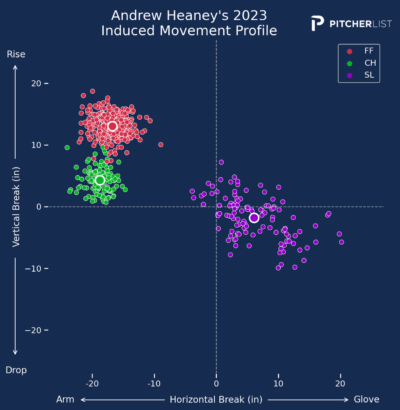
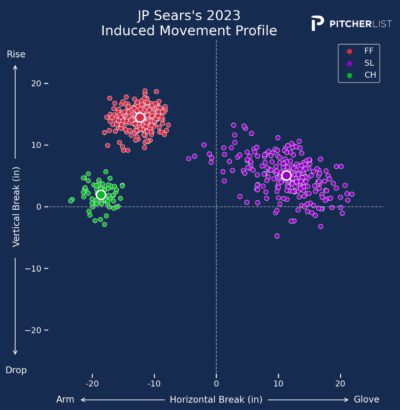
Heaney’s changeup is a bigger part of his arsenal, and vice versa with Sears and his slider. Overall, though, they attack hitters similarly. But Sears also shares something else with Heaney and that’s home runs.
As much as I would like to say that Sears can dodge that problem, it might simply be part of the equation. As a pitcher that frequents the top half of the zone with a fastball that hovers just over 92, he’ll find himself frequenting the caprices of fortune in the form of barrels on batted balls. So where does that leave things?
Sears’ strikeout rate is up and his walks are down too. The slider and fastball combo is legit and PLV certified. Given his exemplary numbers in the minors and the improvements this year, I think he’s someone who would otherwise earn more hype.
But, alas, he’s stuck pitching in Oakland, and that’s no doubt a buzzkill. The home runs might also remain a stick in the mud. Still, Sears has some really good ability and is better than his five-something ERA would indicate. Don’t be surprised to see him stacking up strikeouts while being one of the few bright spots out in Oakland.

